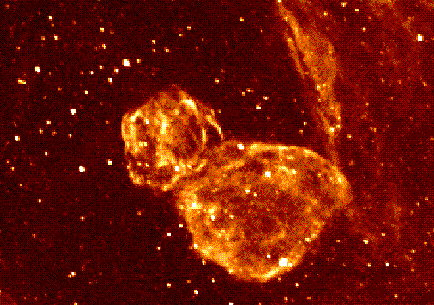
|
Explanation: When a massive star exhausts its nuclear fuel it explodes. This stellar detonation, a supernova, propels vast amounts of starstuff outwards, initially at millions of miles per hour. For another 100,000 years or so the expanding supernova remnant gradually slows as it sweeps up material and ultimately merges with the gas and dust of interstellar space. Short lived by cosmic standards, these stellar debris clouds are relatively rare and valuable objects for astronomers exploring the life cycles of stars. Yet this double bubble-shaped nebula 160,000 light-years away in the Large Magellanic Cloud may represent something rarer still - the collision of two supernova remnants. This image in the light of excited Hydrogen atoms along with images at X-Ray, radio and other optical wavelengths, suggests that the bubbles are indeed two separate regions of hot gas surrounded by cooler dense shells begining to interact as they expand and make contact.
|
January February March April May June July August September October November December |
| ||||||||||||||||||||||||||||||||||||||||||||||||
NASA Web Site Statements, Warnings, and Disclaimers
NASA Official: Jay Norris. Specific rights apply.
A service of: LHEA at NASA / GSFC
& Michigan Tech. U.
Based on Astronomy Picture
Of the Day
Publications with keywords: nebula - remnants - LMC - supernova remnant - supernova
Publications with words: nebula - remnants - LMC - supernova remnant - supernova
See also:
- APOD: 2025 June 9 Á Between Scylla and Charybdis: A Double Cosmic Discovery
- APOD: 2025 March 18 Á LDN 1235: The Shark Nebula
- Supernova Remnant Cassiopeia A
- APOD: 2025 January 8 Á Supernova Remnants Big and Small
- APOD: 2024 September 18 Á The Mermaid Nebula Supernova Remnant
- APOD: 2024 June 11 Á Colorful Stars and Clouds near Rho Ophiuchi
- APOD: 2024 April 16 Á Filaments of the Vela Supernova Remnant
